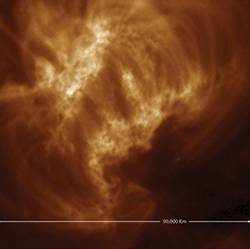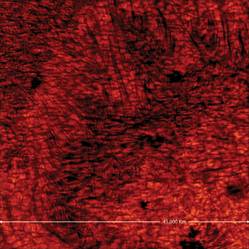

(An image of a magnetic loop complex as captured on July 22, 2011 by the Atmospheric Imaging Assembly on the Solar Dynamics Observatory. The image shows light in the 193 Angstrom wavelength. Credit: NASA/SDO/AIA
Right: This covers the area of the sun roughly in the middle of that shown in the SDO image on the left, as captured by the New Solar Telescope. Together the images were used to observe and analyze ultrafine loops of magnetized material in the sun's atmosphere)
Recently, under the support of Major Program of National Natural Science Foundation of China (10833007), Dr. JI Haisheng, the researcher of PMO, cooperating with Professor Philip Goode and associated Professor CAO Wendao of Big Bear Solar Observatory (BBSO),with the 1.6 m aperture New Solar Telescope (NST) at BBSO, for the first time carried out high resolution imaging observations of the Sun at He I 1083 nm using the 1083 nm Lyot filter made by the Nanjing Institute for Astronomical and Optical Technology and achieved great success. For the first time, scientists of China and U.S. obtained the highest resolution images of the Sun at 1083 nm and discovered structures of ultrafine magnetic loops with a surprisingly narrow diameter of only about 100 km. These ultrafine magnetic loops are ubiquitous on the Sun and rooted in convection intergranular lanes. By combining simultaneous observations from NASA's Solar Dynamics Observatory (SDO) for the high temperature coronal plasma, they are identified as ultrafine channels of the outside flowing of high temperature material and energy. This finding is expected to resolve the long standing puzzle of "solar coronal heating". The result is published in ApJ Letter with the first author from PMO in May this year.
What causes the anomalous heating of solar corona is an unresolved question, which along with dark matter and dark energy puzzles et al. is chosen as one of the eight most compelling mysteries of astronomy by the journal of Science. Resolving the puzzle of coronal heating is taken to be one of the main scientific objectives by almost all the most important international solar instruments, such as Hinode satellite launched in 2006 by Japan. It is also one of the important scientific objectives of SDO satellite launched in 2010 by NASA.
The finding fundamentally answers where on the photosphere the energy comes from to heat the corona. Possible physical process is as follows: the continuous convection motions of the photosphere granules concentrate magnetic fields to the place of intergranules, forming small scaled strong magnetic fields in intergranules. Then the dynamics of the strong intergranular magnetic fields produce the out flowing of high temperature material and energy.
The result is reported by the web site of the National Natural Science Foundation of China, see http://www.nsfc.gov.cn/Portal0/InfoModule_375/48855.htm. More recently, NASA releases news for this result, see http://www.nasa.gov/mission_pages/sunearth/news/corona-loops.html.
(Information Source: Purple Mountain Observatory)

